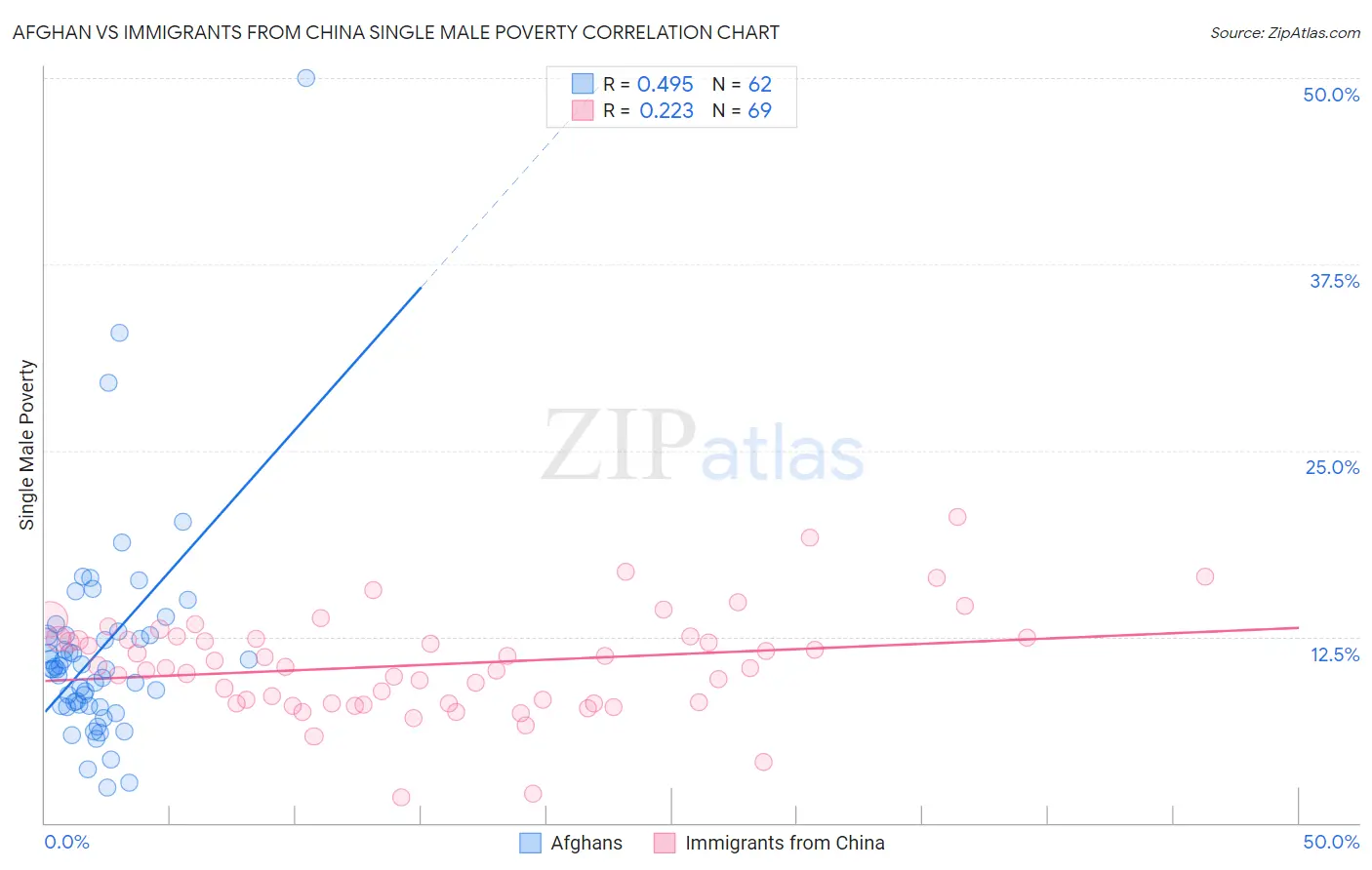Afghan vs Immigrants from China Single Male Poverty
COMPARE
Afghan
Immigrants from China
Single Male Poverty
Single Male Poverty Comparison
Afghans
Immigrants from China
10.7%
SINGLE MALE POVERTY
100.0/ 100
METRIC RATING
7th/ 347
METRIC RANK
11.4%
SINGLE MALE POVERTY
100.0/ 100
METRIC RATING
27th/ 347
METRIC RANK
Afghan vs Immigrants from China Single Male Poverty Correlation Chart
The statistical analysis conducted on geographies consisting of 140,679,200 people shows a moderate positive correlation between the proportion of Afghans and poverty level among single males in the United States with a correlation coefficient (R) of 0.495 and weighted average of 10.7%. Similarly, the statistical analysis conducted on geographies consisting of 395,740,575 people shows a weak positive correlation between the proportion of Immigrants from China and poverty level among single males in the United States with a correlation coefficient (R) of 0.223 and weighted average of 11.4%, a difference of 6.3%.

Single Male Poverty Correlation Summary
| Measurement | Afghan | Immigrants from China |
| Minimum | 2.4% | 1.7% |
| Maximum | 50.0% | 20.6% |
| Range | 47.6% | 18.8% |
| Mean | 11.5% | 10.6% |
| Median | 10.3% | 10.5% |
| Interquartile 25% (IQ1) | 7.8% | 8.0% |
| Interquartile 75% (IQ3) | 12.6% | 12.4% |
| Interquartile Range (IQR) | 4.8% | 4.4% |
| Standard Deviation (Sample) | 7.2% | 3.4% |
| Standard Deviation (Population) | 7.2% | 3.4% |
Demographics Similar to Afghans and Immigrants from China by Single Male Poverty
In terms of single male poverty, the demographic groups most similar to Afghans are Thai (10.8%, a difference of 0.47%), Taiwanese (10.9%, a difference of 1.7%), Immigrants from Fiji (10.9%, a difference of 1.8%), Immigrants from Philippines (10.9%, a difference of 1.8%), and Immigrants from Afghanistan (10.9%, a difference of 1.9%). Similarly, the demographic groups most similar to Immigrants from China are Immigrants from Japan (11.3%, a difference of 0.71%), Maltese (11.3%, a difference of 1.0%), Indian (Asian) (11.3%, a difference of 1.1%), Bolivian (11.2%, a difference of 1.3%), and Immigrants from Pakistan (11.2%, a difference of 1.5%).
| Demographics | Rating | Rank | Single Male Poverty |
| Afghans | 100.0 /100 | #7 | Exceptional 10.7% |
| Thais | 100.0 /100 | #8 | Exceptional 10.8% |
| Taiwanese | 100.0 /100 | #9 | Exceptional 10.9% |
| Immigrants | Fiji | 100.0 /100 | #10 | Exceptional 10.9% |
| Immigrants | Philippines | 100.0 /100 | #11 | Exceptional 10.9% |
| Immigrants | Afghanistan | 100.0 /100 | #12 | Exceptional 10.9% |
| Immigrants | South Central Asia | 100.0 /100 | #13 | Exceptional 10.9% |
| Chinese | 100.0 /100 | #14 | Exceptional 11.0% |
| Koreans | 100.0 /100 | #15 | Exceptional 11.0% |
| Bhutanese | 100.0 /100 | #16 | Exceptional 11.1% |
| Tsimshian | 100.0 /100 | #17 | Exceptional 11.1% |
| Immigrants | Bolivia | 100.0 /100 | #18 | Exceptional 11.1% |
| Immigrants | Moldova | 100.0 /100 | #19 | Exceptional 11.2% |
| Ethiopians | 100.0 /100 | #20 | Exceptional 11.2% |
| Asians | 100.0 /100 | #21 | Exceptional 11.2% |
| Immigrants | Pakistan | 100.0 /100 | #22 | Exceptional 11.2% |
| Bolivians | 100.0 /100 | #23 | Exceptional 11.2% |
| Indians (Asian) | 100.0 /100 | #24 | Exceptional 11.3% |
| Maltese | 100.0 /100 | #25 | Exceptional 11.3% |
| Immigrants | Japan | 100.0 /100 | #26 | Exceptional 11.3% |
| Immigrants | China | 100.0 /100 | #27 | Exceptional 11.4% |